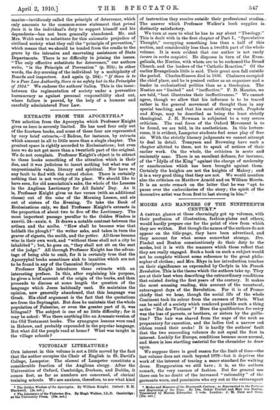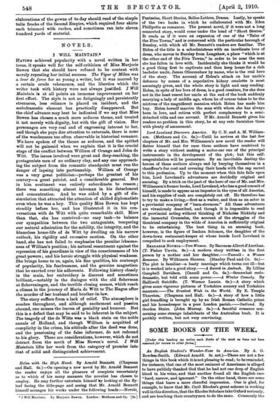MODES AND MANNERS OF THE NINETEENTH CENTURY A emattAL glance
at these charmingly got up volumes, with their profusion of illustration, fashion-plates and others; would hardly prepare one for the point of view from which they are written. But though the names of the authors do not appear on the title-page, they have been advertised, and they account for what seems somewhat strange. .Drs. Fische' and Boehm conscientiously do their daty to the modes, but it is with the manners which these reflect that they are really engaged. Such a book on such a subject would not be complete without some reference to the great philo- sopher of clothes ; and Mrs. Rhys in her introduction touched on their significance as expounded by Carlyle in his French Revolution. This is the theme which the authors take up. They are at their best when describing the extraordinary conditions that existed during the first years of the century. It makes the most amazing reading, this account of the unnatural, extravagant days of the Revolution. For it is of France chiefly that we hear, though the social life of the whole Continent took its colour from the excesses of Paris. What can be said of a society which rendered possible such a thing as the "Bal des Victimes " ? Here the qualification for entry- was the loss of parents, or brothers, or sisters by the guillo- tine? The hair was shaved from the nape of the neck as. preparatory for execution, and the ladies tied a narrow red, ribbon round their necks ! It is hardly the authors' fault that the two succeeding volumes do not equal the first in, interest. Luckily for Europe, conditions became more normal, and there is less startling material for the chronicler to draw upon.
We suppose there is good reason for the limit of time—the last volume does not reach beyond 1878—but it deprives the work of the interest of tracing a saner standard for walking dress. Exaggeration we still have ; it is, as the authors remark, the very essence of fashion. But for general use there can be no doubt of the increased " rationality " of the garments worn, and pessimists who cry out at the extravagant
• Modes and Manners of the Nineteenth Century ; as Represented in the Pictures and Engravings of the Time. By Drs. Oskar Fischel and Max von Boehm. Translated by Marian Edwardes. 3 vols. London T. M. Dent and Sons. Pla, net.)
elaborations of the gowns of to-day should read of the simple tulle frocks of the Second Empire, which required four skirts each trimmed with ruches, and sometimes ran into eleven hundred yards of material.











































 Previous page
Previous page